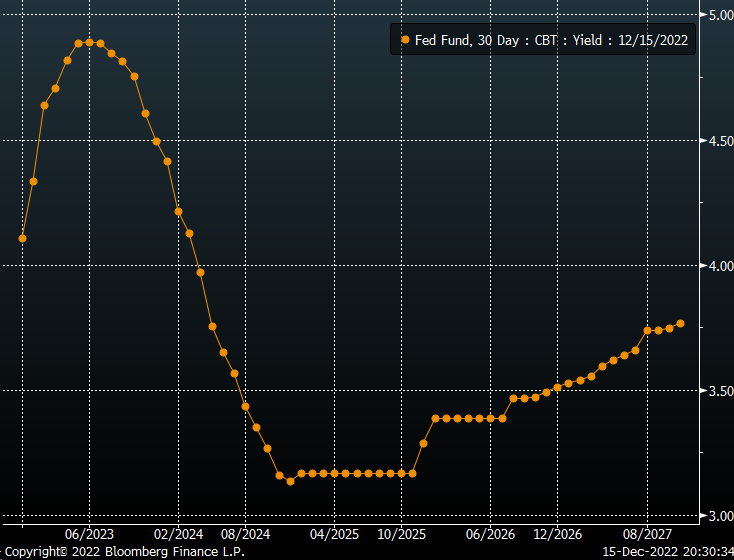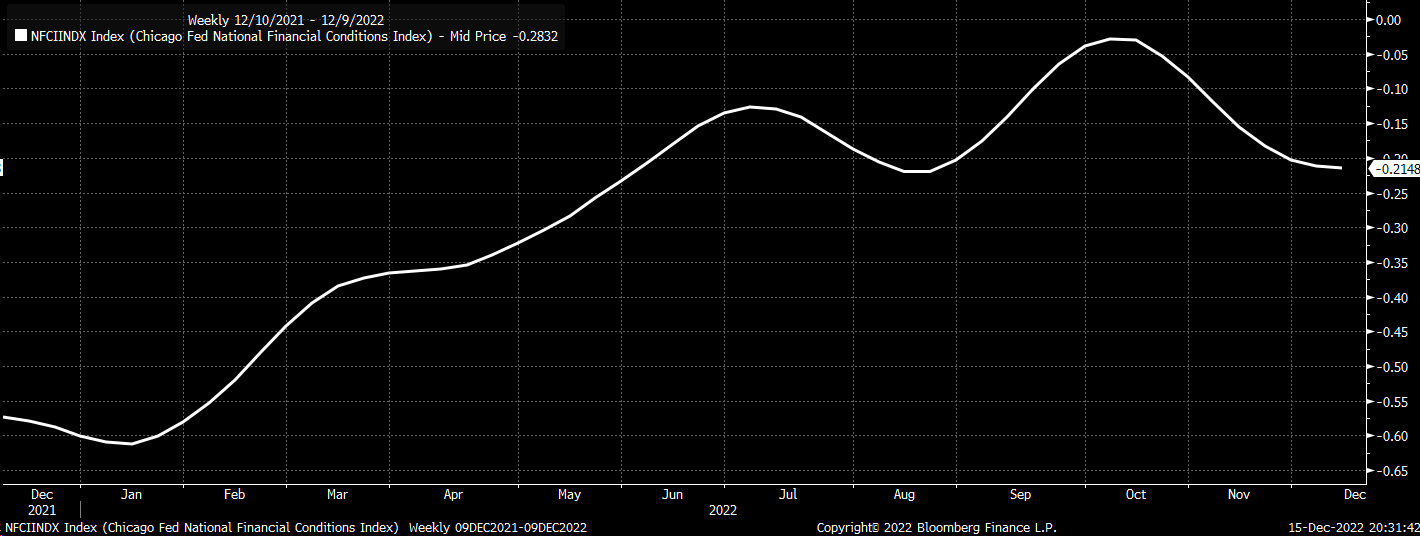- The bond market seems to be unimpressed by the Fed’s policy path
- Bond yields have hardly budged since this week’s FOMC meeting
- The Fed will need to get financial conditions to tighten to be successful in bringing down inflation.
With Jay Powell and the Federal Reserve on one side and the market on the other, a decisive showdown is starting to look inevitable. The Fed wants rates to rise to bring inflation down; the bond market thinks the Fed has already raised rates too far, and a recession is coming.
The question is who will be correct because only one will be. The recent CPI data below expectations only emboldened the inflation doves. Despite the falling inflation rate, the Fed has projected that the overnight rate will rise to 5.1% by the end of 2023.
With the Fed’s aggressive policy path, yields have hardly budged. December Fed Funds futures for 2023 are currently trading at a rate of about 4.5%, which is 60 bps below the target the Fed laid out.

Financial Conditions Have Eased
The lack of market response probably leaves the Fed feeling somewhat disappointed and perhaps wondering what it needs to do or say next to get rates to rise so that financial conditions can tighten.
The Chicago Fed's Financial Conditions Index has shown a significant amount of easing since the middle of October. The Fed wants those conditions to tighten and to head back toward zero. A level below zero suggests that financial conditions are accommodative and favorable to the economy, while readings above zero mean the conditions are restrictive and work against the economy.
For those financial conditions to tighten, the Fed needs rates to rise and spreads between corporate, high-yield, and Treasury bonds to widen. It needs equity prices to fall and implied volatility to increase.
Increasing the Pace of the Run-off
This leaves the Fed in a place to either let things stay where they are or let the market sort itself out. Or, it means the Fed will have to step up its efforts and get more hawkish than what it has already been. While that may not seem possible, the one trick they may have left is the balance sheet run-off card, and they could say it has proceeded at a slower pace than anticipated and, as a result, will look to increase the rate of that run-off in the future.
While the market may think the Fed is wrong, and the data supports the Fed not having to tighten to 5.1%, the market is working against itself. The easier financial conditions are, the more likely it will be that the Fed will need to raise rates over 5% because the market isn't doing the Fed's dirty work.
That is the irony in the whole situation; the tighter the market allows financial conditions to become, the less the Fed would have to raise rates.
***
Charts used with the permission of Bloomberg Finance LP. This report contains independent commentary to be used for informational and educational purposes only. Michael Kramer is a member and investment adviser representative with Mott Capital Management. Mr. Kramer is not affiliated with this company and does not serve on the board of any related company that issued this stock. All opinions and analyses presented by Michael Kramer in this analysis or market report are solely Michael Kramer's views. Readers should not treat any opinion, viewpoint, or prediction expressed by Michael Kramer as a specific solicitation or recommendation to buy or sell a particular security or follow a particular strategy. Michael Kramer's analyses are based upon information and independent research that he considers reliable, but neither Michael Kramer nor Mott Capital Management guarantees its completeness or accuracy, and it should not be relied upon as such. Michael Kramer is not under any obligation to update or correct any information presented in his analyses. Mr. Kramer's statements, guidance, and opinions are subject to change without notice. Past performance is not indicative of future results. Past performance of an index is not an indication or guarantee of future results. It is not possible to invest directly in an index. Exposure to an asset class represented by an index may be available through investable instruments based on that index. Neither Michael Kramer nor Mott Capital Management guarantees any specific outcome or profit. You should know the real risk of loss in following any strategy or investment commentary presented in this analysis. Strategies or investments discussed may fluctuate in price or value. Investments or strategies mentioned in this analysis may not be suitable for you. This material does not consider your particular investment objectives, financial situation, or needs and is not intended as a recommendation appropriate for you. You must make an independent decision regarding investments or strategies in this analysis. Upon request, the advisor will provide a list of all recommendations made during the past twelve months. Before acting on information in this analysis, you should consider whether it is suitable for your circumstances and strongly consider seeking advice from your own financial or investment adviser to determine the suitability of any investment. Michael Kramer and Mott Capital received compensation for this article.
